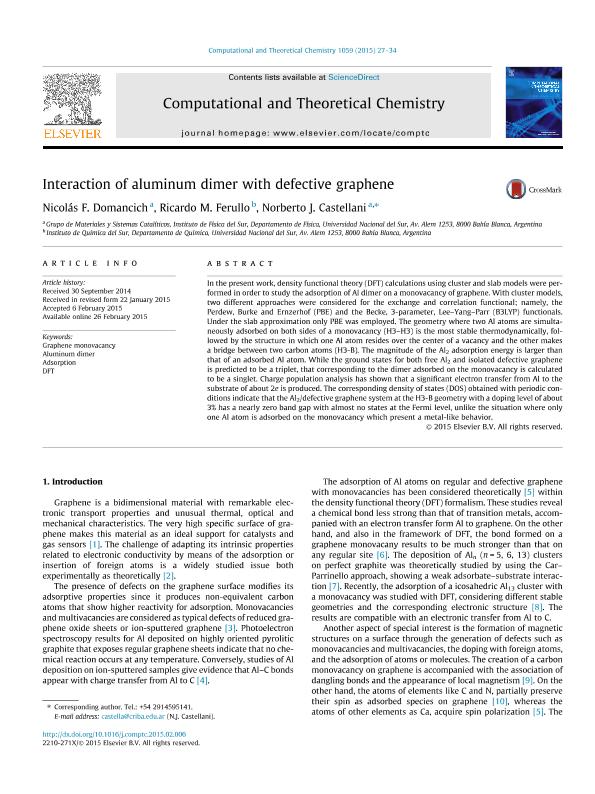Mostrar el registro sencillo del ítem
dc.contributor.author
Domancich, Nicolás Fernando

dc.contributor.author
Ferullo, Ricardo

dc.contributor.author
Castellani, Norberto Jorge

dc.date.available
2017-09-21T14:03:29Z
dc.date.issued
2015-02-26
dc.identifier.citation
Domancich, Nicolás Fernando; Ferullo, Ricardo; Castellani, Norberto Jorge; Interaction of aluminum dimer with defective graphene; Elsevier; Computational and Theoretical Chemistry; 1059; 26-2-2015; 27-34
dc.identifier.issn
2210-271X
dc.identifier.uri
http://hdl.handle.net/11336/24782
dc.description.abstract
In the present work, density functional theory (DFT) calculations using cluster and slab models were performed in order to study the adsorption of Al dimer on a monovacancy of graphene. With cluster models, two different approaches were considered for the exchange and correlation functional; namely, the Perdew, Burke and Ernzerhof (PBE) and the Becke, 3-parameter, Lee?Yang?Parr (B3LYP) functionals. Under the slab approximation only PBE was employed. The geometry where two Al atoms are simultaneously adsorbed on both sides of a monovacancy (H3?H3) is the most stable thermodynamically, followed by the structure in which one Al atom resides over the center of a vacancy and the other makes a bridge between two carbon atoms (H3-B). The magnitude of the Al2 adsorption energy is larger than that of an adsorbed Al atom. While the ground states for both free Al2 and isolated defective graphene is predicted to be a triplet, that corresponding to the dimer adsorbed on the monovacancy is calculated to be a singlet. Charge population analysis has shown that a significant electron transfer from Al to the substrate of about 2e is produced. The corresponding density of states (DOS) obtained with periodic conditions indicate that the Al2/defective graphene system at the H3-B geometry with a doping level of about 3% has a nearly zero band gap with almost no states at the Fermi level, unlike the situation where only one Al atom is adsorbed on the monovacancy which present a metal-like behavior.
dc.format
application/pdf
dc.language.iso
eng
dc.publisher
Elsevier

dc.rights
info:eu-repo/semantics/openAccess
dc.rights.uri
https://creativecommons.org/licenses/by-nc-sa/2.5/ar/
dc.subject
Graphene
dc.subject
Cluster Models
dc.subject
Aluminum Clusters
dc.subject
Dft
dc.title
Interaction of aluminum dimer with defective graphene
dc.type
info:eu-repo/semantics/article
dc.type
info:ar-repo/semantics/artículo
dc.type
info:eu-repo/semantics/publishedVersion
dc.date.updated
2017-05-03T20:04:43Z
dc.journal.volume
1059
dc.journal.pagination
27-34
dc.journal.pais
Países Bajos

dc.journal.ciudad
Amsterdam
dc.description.fil
Fil: Domancich, Nicolás Fernando. Consejo Nacional de Investigaciones Científicas y Técnicas. Centro Científico Tecnológico Conicet - Bahía Blanca. Instituto de Física del Sur. Universidad Nacional del Sur. Departamento de Física. Instituto de Física del Sur; Argentina
dc.description.fil
Fil: Ferullo, Ricardo. Consejo Nacional de Investigaciones Científicas y Técnicas. Centro Científico Tecnológico Conicet - Bahía Blanca. Instituto de Química del Sur. Universidad Nacional del Sur. Departamento de Química. Instituto de Química del Sur; Argentina
dc.description.fil
Fil: Castellani, Norberto Jorge. Consejo Nacional de Investigaciones Científicas y Técnicas. Centro Científico Tecnológico Conicet - Bahía Blanca. Instituto de Física del Sur. Universidad Nacional del Sur. Departamento de Física. Instituto de Física del Sur; Argentina
dc.journal.title
Computational and Theoretical Chemistry
dc.relation.alternativeid
info:eu-repo/semantics/altIdentifier/doi/http://dx.doi.org/10.1016/j.comptc.2015.02.006
dc.relation.alternativeid
info:eu-repo/semantics/altIdentifier/url/http://www.sciencedirect.com/science/article/pii/S2210271X15000778
Archivos asociados
